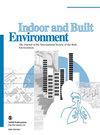有肋片和无肋片导入式紫外线杀菌辐照系统中的辐射场和流场建模
IF 2.9
3区 工程技术
Q2 CONSTRUCTION & BUILDING TECHNOLOGY
引用次数: 0
摘要
导入式紫外线杀菌辐照系统(ID-UV)是开发生物安全建筑的一项前景广阔的技术。本研究探索了计算流体动力学(CFD)方法,以准确预测 ID-UV 的灭活效率。结果表明,"除数 "的设置对辐射场建模的准确性至关重要,在本研究中,15 × 15 被认为是一个合理的值。此外,停留时间和沉积率是决定微生物颗粒接受的平均紫外线剂量(AD)的两个关键参数,从而影响灭活效率。对于不带肋条的 ID 紫外线,归一化组(RNG)[公式:见正文]模型在很大程度上高估了这两个参数,而修正了波动速度的雷诺应力模型(RSM)则将 AD 的预测精度提高了 10.0%。对于带肋条的 ID-UVs,RNG[计算公式:见正文]模型分别高估了 28.6% 和 12.0% 的漩涡大小和 AD。RSM 模型提供的结果更接近大涡模拟。添加 0.10 H(H:管道高度)的肋条可将 MS2 噬菌体的灭活效率提高 19.0%-64.3%,而额外的压降仅为 3.3 Pa。本文章由计算机程序翻译,如有差异,请以英文原文为准。
Modelling of radiation and flow fields in in-duct ultraviolet germicidal irradiation systems with and without ribs
In-duct ultraviolet germicidal irradiation systems (ID-UVs) is a promising technology for the development of biosecure buildings. This study explored the Computational Fluid Dynamics (CFD) method for accurately predicting the inactivation efficiency of ID-UVs. The results showed that the setting of ‘Divisions’ is crucial to the accuracy of radiation field modelling, and 15 × 15 was considered to be a reasonable value in this study. In addition, residence time and deposition ratio are two crucial parameters determining the average UV dose (AD) received by microbial particles, thereby influencing the inactivation efficiency. For ID-UVs without ribs, the Renormalization Group (RNG) [Formula: see text] model largely overestimated these two parameters, while the Reynolds Stress Model (RSM) with correcting fluctuation velocity improved the predictive accuracy of AD by 10.0%. For ID-UVs with ribs, the RNG [Formula: see text] model overestimated the eddy size and AD by 28.6% and 12.0%, respectively. The RSM model provided results closer to the Large Eddy Simulation. Adding 0.10 H (H: duct height) ribs increased the inactivation efficiency for MS2 Bacteriophage by 19.0%–64.3%, with an additional pressure drop of only 3.3 Pa. These findings contributed to a reliable CFD framework and provided novel ideas for improving inactivation efficiency.
求助全文
通过发布文献求助,成功后即可免费获取论文全文。
去求助
来源期刊

Indoor and Built Environment
环境科学-工程:环境
CiteScore
6.40
自引率
25.00%
发文量
130
审稿时长
2.6 months
期刊介绍:
Indoor and Built Environment publishes reports on any topic pertaining to the quality of the indoor and built environment, and how these might effect the health, performance, efficiency and comfort of persons living or working there. Topics range from urban infrastructure, design of buildings, and materials used to laboratory studies including building airflow simulations and health effects. This journal is a member of the Committee on Publication Ethics (COPE).
 求助内容:
求助内容: 应助结果提醒方式:
应助结果提醒方式:


